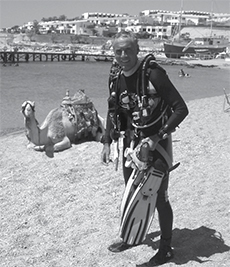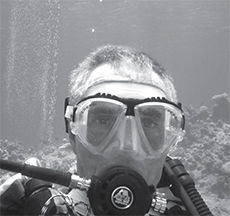




| Home | Features | Club Nights | Underwater Pics | Feedback | Non-Celebrity Diver | Events | 31 July 2025 |
| Blog | Archive | Medical FAQs | Competitions | Travel Offers | The Crew | Contact Us | MDC | LDC |

|

|
 
 |
 |
ISSUE 13 ARCHIVE - BEST DIVE, WORST DIVE, LAURIE CUMMINGSMy name is Laurie Cummings and I was born on the 14th. January, 1941 in a small colliery village called Easington Colliery in the County of Durham. I left school in 1956 and became an electrician at the local colliery and remained there until 1963 when I joined the Durham Constabulary as a Police Constable. During my service in the force I became an active member of the force Athletics Team and soon began to excel in athletics.In 1992/3 I took part in the Veterans World Championships where I obtained three world rankings: 9th as a Marathon Runner, 9th as a 25K Road Runner and 24th as a 10K Road Runner. During this period of 1963/1993 it was frowned upon to deviate from the athletics training. I always wanted to learn to scuba dive and as a result of a slight knee injury I was able to turn to scuba diving in 1993. I joined my local Bishop Auckland Diving Club as a BSAC Member. Having got addicted to the diving I soon reached the rank of Assistant Club Instructor and began diving all over the North-East coast and West Coast of Scotland. |
 |
 |
I soon wanted to try diving elsewhere and
so I ended up at The Aegean Pro Dive
Centre, Bodrum, Turkey where I worked until
2005 as a dive guide. This was followed by
a move to Colona Dive Centre, Hadaba,
Sharm-el-Sheikh, Egypt, where I still work
as a dive guide today.
To date I have now made 11,000 dives and am just heading off into the water again! BEST: Without a doubt my best dive has to be on the Shark/Yolanda dive site which is situated in the Ras Mohammed National Park, Sharm-el- Sheikh, Egypt. This dive site is rated to be in the top ten dive sites in the world. The geographic position of the Ras Mohammed Peninsula is an area known for its strong massive currents that obviously carry huge quantities of plankton and other food that attract large schools of fish life. With this tremendous food supply there are always numerous species of fish and many different species of corals. Most of the big fish such as greater baracuda, reef sharks, tuna, jackfish are plentiful at anytime of the day or year. Other interesting species are the Napoleon wrasse. One in particular has been living in or around the reef for as long as I have dived this area (pre-2005). It can be recognised by a scar on the right hand side of its mouth where a fish hook had become embedded and it eventually managed to pull it free. It is one of the oldest Napoleon in the area, as judging by its head it is estimated to be at least forty years old. |
|
|
Besides the Napoleon there are two very distinct turtles living around
the reef. One being old and the other quite young as its shell looks as
though it has just been re-varnished.
The dive commences at the North-East corner of Shark Reef where, as you drop down, you see a spectacular sheer wall (drop off). If the current is favourable then you continue the dive with your right shoulder to the reef which drops down into the abyss. Travelling along the wall you are confronted by all the big fish (photographers' paradise!) and maybe the odd shark swimming below. You then come across a saddle between Shark and Yolanda Reefs. Aiming for the saddle can result in spectacular views of many type and colours of corals. Keep looking up to the surface and one will see small schools of squid hovering about the ten metre mark. Carry on through the saddle and the view includes what I would call a desert and scattered about are coral of every description where giant morays linger in the nooks and crannies. As you are now at the rear of Yolanda you carry on along the wall with the left shoulder to it. Here you come across dozens of trumpet fish just lingering next to the reef wall. Continuing on, you then come across the cargo of the Yolanda which sank some years ago. The cargo has made a home for the likes of morays, stonefish, scorpionfish, blue spotted sting rays and many more. Carry on over the cargo and note the BMW motor car amongst the wreckage, battered, but still recogniseable (this was the captain's car which he always transported about with him, and went down with the ship when it sank). The next things worthy of note that you will see are those of the toilets, hand-basins and baths that were destined for Sharm-el-Sheikh along with the rolls on linoleum. Near to the baths there will always be one or two crocodile fish. The safest place to now ascend is the reef wall of Yolanda where a safety stop is a must and the use of an SMB essential especially in adverse weather conditions. Once on the surface signal to your respective dive boat to come and pick you up. WORST: Without fear or favour my worst ever dive was that carried out on the Lighthouse Wall in the Farne Islands, Northumberland. This dive was my first sea dive and one that I will never forget as long as I live. The Farnes are notorious for the current that prevail at the best of times, but, in particular they are frightening, to say the least, when there is an ebb tide. This is when my Club Instructor (who shall remain nameless) at that time decided that the club would dive the Farne Islands. |
 | |
|
He got the tide times totally wrong and as a novice I didn't know any
better either. We were using the club's rib at the time, with about
six members aboard all keen to dive the site. I was to dive with him
because I was the novice and because he was the Club Instructor
who knew everything.
A shot line was dropped to the sea bed, which was approximately thirty metres and the rib was duly anchored in what was supposed to be calm waters. What a shock we were about to experience. The thought of going down to thirty metres was enough for me to wonder what I was doing here in the North Sea. Only one thing was in our favour and that was the calm sea with only a heavy ripple on the surface, which even I knew as a novice, indicated heavy current. I had learned this as the result of living by the sea as a youngster. Not to be beaten, the instructor went first down the shot-line followed by a shaky me. Who said "never dive if you feel unsafe"? I was as good as forced into it, whether I liked it or not! As I slipped over the side I did not quite manage to get a hold on the side of the rib and consequently got pushed away from the rib by the current and as I was passing the back of the rib someone grabbed hold of me and hauled me alongside the rib until I came in contact with the shot-line. I thought "no way am I going to descend into the unknown", but, encouraged by people shouting at me, I reluctantly started to descend the line with fear and intrepidation. As soon as my head was underwater my mask started to tremble with the force of the current and the line was bending. I was horizontal with the current trying to push me out into the blue. My knuckles must have been white. I most certainly felt sick. As I gradually descended that line, the bubbles from my regulator were running away from me in a horizontal line. Not to be daunted, I finally got to the bottom of the shot-line only to see that the anchor (for what it was worth) was just about gripping onto a stone. "Oh my God", I thought, "what next?" The Instructor looked at me and indicated for me to let go of the line. I just did not want to, as I imagined, once again, being taken away to the blue yonder. Eventually I let go and all I could really remember was trying to grab a hold on any stone or rock that came my way like an express train. If you pardon the expression – I almost put a love-bite on each rock or stone that I touched or grabbed hold of to stop me being swept away. At this stage the Instructor obviously decided it was too dangerous for us to be down at thirty metres in such conditions, and bearing in mind that I should only have been down to eighteen metres, he signalled for us to return to the surface. This I did without any further persuasion and still was clinging to that shot-line being thrown about by the current. On reaching the surface the Instructor just said words to the effect that he must have got the tide times wrong! From that day forward I vowed NEVER to dive again and yet here we are with 11,000 dives under my belt and very much aware of what can happen on any dive if insufficient thought is not put into the organising of a dive. PLEASE DIVE SAFELY. |
 | |
Previous article « Underwater Photography Next article » At the Chamber Back to Issue 13 Index | ||